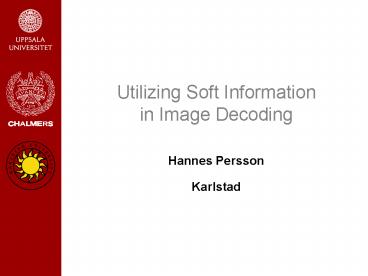Utilizing Soft Information in Image Decoding - PowerPoint PPT Presentation
1 / 18
Title:
Utilizing Soft Information in Image Decoding
Description:
Error concealment. Utilizing Soft Information. Bit-error detection with the arithmetic decoder ... At least make error concealment less frequent. Experimental Set-up ... – PowerPoint PPT presentation
Number of Views:20
Avg rating:3.0/5.0
Title: Utilizing Soft Information in Image Decoding
1
Utilizing Soft Information in Image Decoding
- Hannes Persson
- Karlstad
2
Outline
- Background
- JPEG2000
- Soft information
- Experiments
- Conclusions future work
3
Soft Information in Image Decoding
- General purpose
- Make end-points aware of channel conditions
- Reduce retransmissions
- Maximum a-posteriori (MAP) estimates
- Soft decoding
- Produced at the receiver
- Assume bits are independent and equally likely
- Transparent to the wireless system used
(independent of modulation, coding) - Reliability measure of the received bits
- Express the certainty of a bits value to be
correct
4
Communication Layers
- Modification limited to the receiver
- Assumptions about underlying communication layers
- Overlook bit-errors in user data
- Support inter-layer communication to be able to
forward soft information
Application - JPEG2000 Transport - TCP-L Network
- IP Data link Physical - log-MAP soft information
5
JPEG2000 Overview
Forward wavelet transform
Arithmetic encoder
Compressed data
Quantization
Inverse wavelet transform
Arithmetic decoder
Dequantization
Compressed data
6
Arithmetic Coder
- Arithmetic coder applied to subsets of
transformed data - code-blocks - Restricts the amount of data the arithmetic coder
is exposed to - Bit-errors is contained in the code-block
- No propagation to other code-blocks
- Error resilient mechanisms in JPEG2000
- Encoded at the transmitter
- Bit-error detection with the arithmetic decoder
- Bit-error will stop the decoding of a code-block
- Error concealment
7
Utilizing Soft Information
- Bit-error detection with the arithmetic decoder
- Soft information utilization attempts to correct
bit-errors by iterative arithmetic decoding - Heuristic algorithm that swaps potential
erroneous bits - Potential erroneous bits deduced from soft
information - Goal is to correct all bit-errors in the
code-block - At least make error concealment less frequent
8
Experimental Set-up
- Image code-block size - 4x4, 16x16, 32x32, 64x64
- 16-QAM modulation
- Signal to Noise power relation - 5-16 dB
- Image transmitted 30 times over the noisy channel
(lena image) - Received image decoded with 3 different decoders
AWGN channel simulation
9
6 dB
10
8 dB
11
8 dB
12
8 dB
- Baseline 12.2452 dB Baseline 15.5012 dB
Modified 17.7354 dB - (no mechanisms used) (utilizes
mechanisms) (utilizes mechanisms
soft info.)
13
10 dB
14
10 dB
15
10 dB
- Baseline 18.2799 dB Baseline 19.335 dB
Modified 28.8897 dB - (no mechanisms used) (utilizes
mechanisms) (utilizes mechanisms
soft info.)
16
12 dB
17
Conclusion Future
- Soft information in image decoding
- High gain in image quality possible (8-12dB)
- Both PSNR and visually
- Improvements of 30 percent observed
- Impact of code-block size
- Future
- Enhance algorithm for finding erroneous bits
- Layer interaction for the soft information
exchange - Format on soft information
- Combine with TCP-L
18
Soft information in multimedia
- Multimedia standards already define error
detection mechanisms - Motion JPEG2000
- MPEG-4
- RVLC
- Soft information and iterative decoding
- Soft information already exists
- Implementation issue
- Computational overhead

